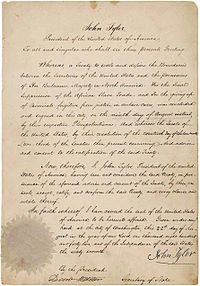Webster–Ashburton Treaty

Webster–Ashburton Treaty ratification.
|
|
| Type | Bilateral treaty |
|---|---|
| Signed | 9 August 1842 |
| Location | Washington, DC, United States |
| Original signatories |
USA UK |
| Ratifiers | USA UK |
The Webster–Ashburton Treaty, signed August 9, 1842, was a treaty resolving several border issues between the United States and the British North American colonies (i.e. the region that became Canada). Signed under John Tyler's presidency, it resolved the Aroostook War, a nonviolent dispute over the location of the Maine–New Brunswick border. It established the border between Lake Superior and the Lake of the Woods, originally defined in the Treaty of Paris in 1783, reaffirmed the location of the border (at the 49th parallel) in the westward frontier up to the Rocky Mountains defined in the Treaty of 1818, defined seven crimes subject to extradition, called for a final end to the slave trade on the high seas, and agreed to shared use of the Great Lakes. The treaty retroactively confirmed the southern boundary of Quebec that had been marked by stone monuments by land surveyors John Collins and Thomas Valentine in 1771–3. It had been intended to be at 45 degrees north latitude, but is in some places nearly a half mile north of the parallel.
The treaty was signed by United States Secretary of State Daniel Webster and British diplomat Alexander Baring, 1st Baron Ashburton.
The Treaty of Paris had established the 45th parallel as part of the northern boundary of modern-day New York and Vermont. Most of that portion of the boundary had previously been surveyed in the early 1770s, but the survey line was inaccurate. Since "Fort Blunder", an unnamed U.S. fort in what is now part of northeastern New York, had been constructed north of the actual 45th parallel, the United States wanted to follow the old survey line, and the Webster–Ashburton treaty incorporated this change, leaving the half-finished fort on U.S. soil. Following the signing of the treaty, construction was resumed on the site. The new project replaced the aborted 1812-era construction with a massive third-system masonry fortification known as Fort Montgomery.
...
Wikipedia
